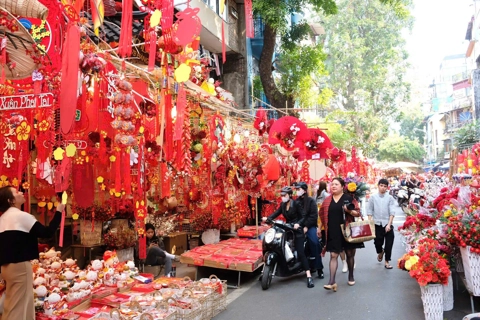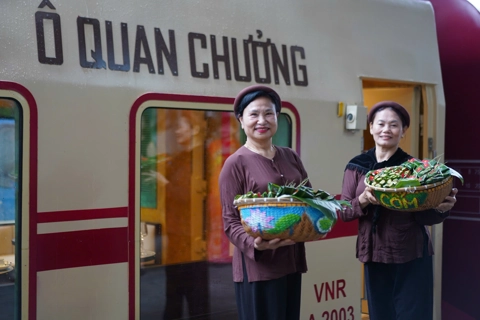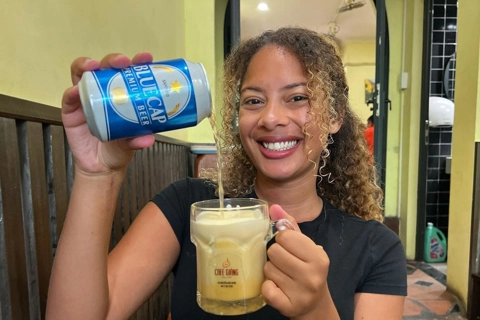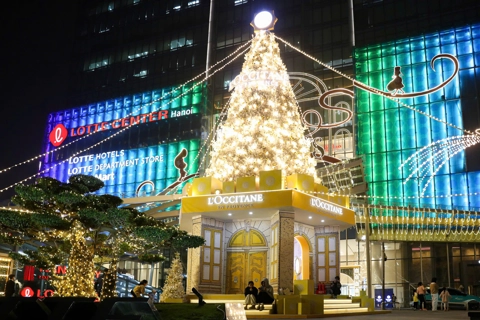Life
Ministry orders removal of foreign-style stone lions
Jan 15, 2015 / 03:26 PM
The Ministry of Culture, Sports and Tourism held a workshop to review a regulation handed down five months ago that bans foreign-style symbols, sculptures and worship objects unsuitable for Vietnamese culture.
The ministry has been targeting foreign-style lion statues so far, but aims to eventually fine people for and remove other items, such as lanterns and other animal statues. Many participants at the workshop yesterday in Ha Noi supported the regulation.
"In the past 20 years, together with open-door policy, many foreign-style symbols, products and animal sculptures have been widely-spread throughout the country, distorting traditional spiritual images," said Vi Kien Thanh, head of the ministry's Fine Arts Department, "That's why the ministry issued the regulation."
Dozens spoke at the workshop to review the first five months spent implementing the new law, Document No. 2662.
According to Vi Kien Thanh, head of the ministry's Fine Arts Department, the regulation has received positive feedback from various sectors and agencies, including the Buddhist Sangha of Viet Nam; People's Committees; and local departments of culture, sports and tourism. The ministry has sent a list of purely Vietnamese holy animals to local authorities for reference.
"In the past 20 years, together with open-door policy, many foreign-style symbols, products and animal sculptures have been widely-spread throughout the country, distorting traditional spiritual images," said Vi Kien Thanh, head of the ministry's Fine Arts Department, "That's why the ministry issued the regulation."
Dozens spoke at the workshop to review the first five months spent implementing the new law, Document No. 2662.
According to Vi Kien Thanh, head of the ministry's Fine Arts Department, the regulation has received positive feedback from various sectors and agencies, including the Buddhist Sangha of Viet Nam; People's Committees; and local departments of culture, sports and tourism. The ministry has sent a list of purely Vietnamese holy animals to local authorities for reference.

In Ha Noi, nearly 150 foreign-style stone lions – 27 per cent of those in the capital – have been taken down from pagodas and relic areas.
Truong Minh Tien, deputy director of Ha Noi's Department of Culture, Sports and Tourism, said authorities had faced various obstacles while implementing the Document.
"Many of our staff have been not quite confident they can distinguish the foreign lions from Vietnamese ones," he said.
Also, many of the lions have been with the pagodas so long they have become part of the holy places, which makes it difficult to persuade locals to remove them, Tien said.
Nguyen Huu Chien, deputy director of Da Nang's Department of Culture, Sports and Tourism, said authorities have seized two pairs of stone lions at two relic sites.
"We have tried our best to create a compromise between authorities and the people," he said.
Getting less business
The ministry's decision means 1,000 workers in the Non Nuoc Stone Carving Village who specialised in making foreign-style lions will get less business. About 4,500 pairs of foreign-style lions in stock can no longer be sold in the country. However, the village will still be able to produce foreign-style lions for export to China, Taiwan and Malaysia.
"We will organise a competition among workshops between January 15 and June 15 to select the best Vietnamese-style lions with decorative patterns," Chien said. "The models then will be applied for the whole village. As for the foreign-style lions that have already been made, we will encourage local workers to carve smaller lions in Vietnamese style or destroy the whole sculptures to recycle the stone powder."
Researcher Vu Minh Giang of Ha Noi National University said people should be taught the difference between Vietnamese lions and others. Vietnamese lions look tolerant and solemn, while others sport fierce expressions, and have large paws and sharp teeth.
"We will need State management, fine art experts and the support of the people in order to be successful," he said.
Painter Tran Khanh Chuong, Chairman of the Viet Nam Fine Arts Association, said pagodas should offer more books on Vietnamese decorative patterns, worship objects and holy animals so people understand the traditional culture better.
He also said many different models of holy animals should be produced in handicraft villages to avoid repetition and promote workers' creativeness.
Venerable Monk Thich Duc Thien, who represented the Buddhist Sangha of Viet Nam at the workshop, said Sangha would co-ordinate with concerned agencies to conduct research on pagoda architecture, worship objects at pagodas and monk costumes, with the aim to teach people more about Vietnamese cultural objects at future workshops.
"We need a broader view on various worship objects and holy sculptures at pagodas, as many things remain unclear even among researchers," he said.
Exhibitions of regular and mythical lion sculptures have been hosted in Ha Noi and Da Nang, drawing 7,000 visitors.
Truong Minh Tien, deputy director of Ha Noi's Department of Culture, Sports and Tourism, said authorities had faced various obstacles while implementing the Document.
"Many of our staff have been not quite confident they can distinguish the foreign lions from Vietnamese ones," he said.
Also, many of the lions have been with the pagodas so long they have become part of the holy places, which makes it difficult to persuade locals to remove them, Tien said.
Nguyen Huu Chien, deputy director of Da Nang's Department of Culture, Sports and Tourism, said authorities have seized two pairs of stone lions at two relic sites.
"We have tried our best to create a compromise between authorities and the people," he said.
Getting less business
The ministry's decision means 1,000 workers in the Non Nuoc Stone Carving Village who specialised in making foreign-style lions will get less business. About 4,500 pairs of foreign-style lions in stock can no longer be sold in the country. However, the village will still be able to produce foreign-style lions for export to China, Taiwan and Malaysia.
"We will organise a competition among workshops between January 15 and June 15 to select the best Vietnamese-style lions with decorative patterns," Chien said. "The models then will be applied for the whole village. As for the foreign-style lions that have already been made, we will encourage local workers to carve smaller lions in Vietnamese style or destroy the whole sculptures to recycle the stone powder."
Researcher Vu Minh Giang of Ha Noi National University said people should be taught the difference between Vietnamese lions and others. Vietnamese lions look tolerant and solemn, while others sport fierce expressions, and have large paws and sharp teeth.
"We will need State management, fine art experts and the support of the people in order to be successful," he said.
Painter Tran Khanh Chuong, Chairman of the Viet Nam Fine Arts Association, said pagodas should offer more books on Vietnamese decorative patterns, worship objects and holy animals so people understand the traditional culture better.
He also said many different models of holy animals should be produced in handicraft villages to avoid repetition and promote workers' creativeness.
Venerable Monk Thich Duc Thien, who represented the Buddhist Sangha of Viet Nam at the workshop, said Sangha would co-ordinate with concerned agencies to conduct research on pagoda architecture, worship objects at pagodas and monk costumes, with the aim to teach people more about Vietnamese cultural objects at future workshops.
"We need a broader view on various worship objects and holy sculptures at pagodas, as many things remain unclear even among researchers," he said.
Exhibitions of regular and mythical lion sculptures have been hosted in Ha Noi and Da Nang, drawing 7,000 visitors.








